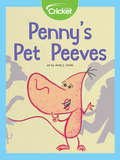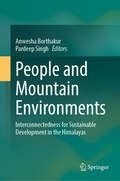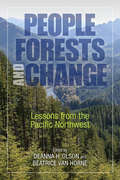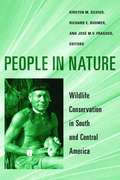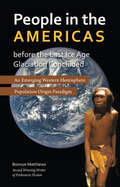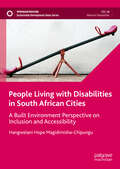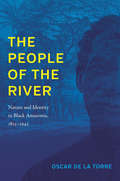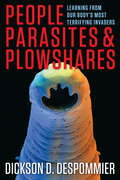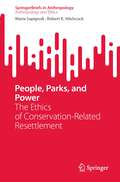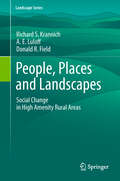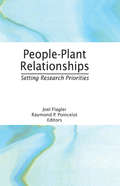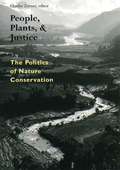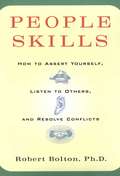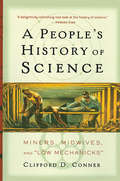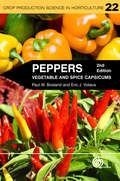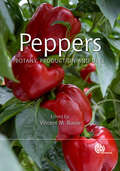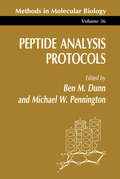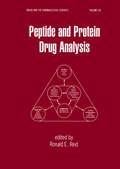- Table View
- List View
Penny, la Cucciola della Ferrovia
by Brian L. PorterLa storia di Penny è il quarto libro di Brian L. Porter della serie vincitrice di premi sui cani salvati, e parla di un piccolo terrier, abbandonato in un modo particolarmente crudele, e della sua conseguente adozione e della vita insieme all’autore e alla sua famiglia. Dall’attacco da parte di un altro cane che porta ad un’operazione urgente, ai giorni sulla spiaggia cacciando i gabbiani, alle Case Signorili, la vita di Penny nel branco di cani di Brian non è stata altro che interessante e piena di eventi. Leggi la sua affascinante storia, una gradita aggiunta alla serie della Famiglia dei Cani Salvati.
Penny's Pet Peeves
by Amy TaoDinosaurs ruled the earth for millions of years. But different dinosaurs had different characteristics. Some weren't even dinosaurs at all.
Penzlin - Lehrbuch der Tierphysiologie
by Jan-Peter Hildebrandt Horst Bleckmann Uwe HombergJan Peter Hildebrandt, Horst Bleckmann und Uwe Homberg haben das Standardlehrbuch der Tierphysiologie von Heinz Penzlin komplett überarbeitet und modernisiert. Den Studierenden bietet es nun den aktuellen State of the Art der vergleichenden Tierphysiologie. Diese integrative Wissenschaftsdisziplin ist wichtig für all jene, die sich in den Bachelor-Vertiefungsphasen oder in Master-Studiengängen der Biowissenschaften mit Fragen der funktionellen Anatomie, der vegetativen Physiologie, der Neurobiologie, der Stoffwechselphysiologie, der Sinnes- und der Muskelphysiologie mit ökologischen, systemisch-vergleichenden oder molekularen Ansätzen beschäftigen.Die neue Auflage nutzt didaktische Elemente, erklärt in Fußnoten Herkunft und Bedeutung von Fachbegriffen, enthält ein Glossar und bietet elektronische Zusatzmaterialien.
People and Mountain Environments: Interconnectedness for Sustainable Development in the Himalayas
by Anwesha Borthakur Pardeep SinghPeople living in the mountains maintain a unique relationship with their surrounding environment. Humans have settled in mountainous regions all across the globe for centuries, adapting to the challenging terrains and establishing exceptional cultural practices and lifestyles. Until today, they depend on their immediate ecosystems for their everyday necessities while also conserving those environments through their own traditional practices and belief systems. Understanding and addressing the ease and complexities of the relationship between people and mountains is essential for sustainable development through overall conservation and well-being of both the environment and the communities living in these regions. The mountain communities in the Himalayas and their interconnectedness with their surroundings could provide important insights in this regard. For instance, the interaction between humans and mountains in the Himalayas is diverse, spanning across various cultural, economic, political, environmental and recreational dimensions and parameters. As sustainable development is a core goal of the world today, it is both interesting and pertinent to explore these various aspects and locate possible learnings in the present-day global environmental scenario. Accordingly, this book is an attempt to situate the interconnected between people and the mountains in the Himalayan landscape towards tracing learnings for sustainable development. Our aim is to edit a holistic volume where aspects ranging from ecosystem services to cultural and spiritual significances of the mountains for the local communities and from contributions of the Himalayas in relation to water, agriculture and food practices to the challenges associated with haphazard infrastructural developments and environmental justice implications are adequately addressed. We acknowledge that balancing the human needs of the mountain communities while ensuring environmental conservation is a major challenge. Ecologically fragile and biodiversity rich the Himalayan region is no exception. Further, mountain communities in the Himalayas are facing tremendous challenges in adapting to changing climate conditions, such as altered precipitation patterns and increased frequency of extreme weather events. Unsustainable economic activities in the form of chaotic tourism practices and infrastructural developments among others add to the emerging challenges. Accordingly, it is important to put research efforts towards active sustainable development practices where human needs are met while minimizing undesirable impacts on the Himalayan mountain ecosystems. The Himalayas are critical for global ecological balance. Therefore, this book will not only be helpful for the countries situated in these mountain regions alone, but also will provide useful insights for environmental sustainability at a much larger global scale.
People and Spaces in Roman Military Bases
by Penelope M. AllisonThis study uses artefact distribution analyses to investigate the activities that took place inside early Roman imperial military bases. Focusing especially on non-combat activities, it explores the lives of families and other support personnel who are widely assumed to have inhabited civilian settlements outside the fortification walls. Spatial analyses, in GIS-type environments, are used to develop fresh perspectives on the range of people who lived within the walls of these military establishments, the various industrial, commercial, domestic and leisure activities in which they and combat personnel were involved, and the socio-spatial organisation of these activities and these establishments. The book includes examples of both legionary fortresses and auxiliary forts from the German provinces to demonstrate that more material-cultural approaches to the artefact assemblages from these sites give greater insights into how these military communities operated and demonstrate the problems of ascribing functions to buildings without investigating the full material record.
People, Forests, and Change: Lessons from the Pacific Northwest
by Beatrice Van Horne Deanna H. OlsonWe owe much of our economic prosperity to the vast forested landscapes that cover the earth. The timber we use to build our homes, the water we drink, and the oxygen in the air we breathe come from the complex forested ecosystem that many of us take for granted. As urban boundaries expand and rural landscapes are developed, forests are under more pressure than ever. It is time to forgo the thinking that forests can be managed outside of human influence, and shift instead to management strategies that consider humans to be part of the forest ecosystem. Only then can we realistically plan for coexisting and sustainable forests and human communities in the future.In People, Forests, and Change: Lessons from the Pacific Northwest, editors Deanna H. Olson and Beatrice Van Horne have assembled an expert panel of social and forest scientists to consider the nature of forests in flux and how to best balance the needs of forests and the rural communities closely tied to them. The book considers the temperate moist-coniferous forests of the US Pacific Northwest, but many of the concepts apply broadly to challenges in forest management in other regions and countries. In the US northwest, forest ecosystem management has been underway for two decades, and key lessons are emerging. The text is divided into four parts that set the stage for forests and rural forest economies, describe dynamic forest systems at work, consider new science in forest ecology and management, and ponder the future for these coniferous forests under different scenarios.People, Forests, and Change brings together ideas grounded in science for policy makers, forest and natural resource managers, students, and conservationists who wish to understand how to manage forests conscientiously to assure their long-term viability and that of human communities who depend on them.
People in Nature: Wildlife Conservation in South and Central America
by José Fragoso Kirsten Silvius Richard BodmerThis book reviews wildlife management and conservation in Central and South America. The book discusses the threats to biodiversity in this area including habitat fragmentation, development, ranching, tourism as well as hunting. The book contains contributions from many local Latin American authors who work there daily and are exposed to the numerous and unique issues that need to be taken into account when talking about conservation in Central and South America.
People in the Americas Before the Last Ice Age Glaciation Concluded: An Emerging Western Hemisphere Population Origin Paradigm
by Bonnye MatthewsWARNING: Everything you know about the peopling of the Americas is wrong.People in the Americas before the Last Ice Age Glaciation Concluded: An Emerging Paradigm on Western Hemisphere Population Origin covers the turn of the century emerging science on the origin of human population in the western hemisphere. It is a booklet that is designed to provide a reference bridge until the new information can be included in textbook presentations. With the ability to examine DNA evidence on extremely old human remains and findings at greater depth than formerly considered, information grows at a rapid rate. The science is in its infancy, but surprising finds occur moment by moment.
People Living with Disabilities in South African Cities: A Built Environment Perspective on Inclusion and Accessibility (Sustainable Development Goals Series)
by Hangwelani Hope Magidimisha-ChipunguThis book offers a unique and much-needed perspective on disability and accessibility in urban context in South Africa. Drawing on lived experiences of disabled people, it documents the multidimensional aspect of poverty in the context of disability and built environment to show how poorly planned cities create physical and social barriers that impact the life of people with disabilities. People Living with Disabilities in South African Cities is structured around three main insights and themes that inform the author's approach to disability and cities. The first is disability research; drawing on studies on planning and the built environment, the author highlights the role of physical environment in promoting inclusion and accessibility for people with disabilities. The second theme is social protection, i.e. ways to provide support and resources for people with disabilities to enable them to participate fully in society. Finally, the author explores the policies and legislative context needed to create an inclusive society, challenging the role of governments and policy makers. Offering a comprehensive approach to studying disabilities and cities, the author aims to bridge the gap between disability studies, inclusive planning, and design to support the development of accessible cities in the African context. This invaluable book not only raises awareness on social inclusion, but also offers an invaluable guide to policy makers across the Global South to tackle and address inequalities.
People of the Lake: Mankind and its Beginnings
by Richard E. Leakey Roger LewinIn the crocodile-infested waters near Lake Turkana in Kenya, Leaky is piecing together the clues of an ancient puzzle, reconstructing the world of our primeval forefathers in eerie detail.
The People of the River: Nature and Identity in Black Amazonia, 1835–1945
by Oscar de la TorreIn this history of the black peasants of Amazonia, Oscar de la Torre focuses on the experience of African-descended people navigating the transition from slavery to freedom. He draws on social and environmental history to connect them intimately to the natural landscape and to Indigenous peoples. Relying on this world as a repository for traditions, discourses, and strategies that they retrieved especially in moments of conflict, Afro-Brazilians fought for autonomous communities and developed a vibrant ethnic identity that supported their struggles over labor, land, and citizenship.Prior to abolition, enslaved and escaped blacks found in the tropical forest a source for tools, weapons, and trade--but it was also a cultural storehouse within which they shaped their stories and records of confrontations with slaveowners and state authorities. After abolition, the black peasants' knowledge of local environments continued to be key to their aspirations, allowing them to maintain relationships with powerful patrons and to participate in the protest cycle that led Getulio Vargas to the presidency of Brazil in 1930. In commonly referring to themselves by such names as "sons of the river," black Amazonians melded their agro-ecological traditions with their emergent identity as political stakeholders.
People, Parasites, and Plowshares: Learning from Our Body's Most Terrifying Invaders
by Dickson DespommierDickson D. Despommier's vivid, visceral account of the biology, behavior, and history of parasites follows the interplay between these fascinating life forms and human society over thousands of years. Despommier focuses on long-term host-parasite associations, which have evolved to avoid or even subvert the human immune system. Some parasites do great damage to their hosts, while others have signed a kind of "peace treaty" in exchange for their long lives within them. Many parasites also practice clever survival strategies that medical scientists hope to mimic as they search for treatments for Crohn's disease, food allergies, type 1 diabetes, organ transplantation, and other medical challenges. Despommier concentrates on particularly remarkable and often highly pathogenic organisms, describing their lifecycles and the mechanisms they use to avoid elimination. He details their attack and survival plans and the nature of the illnesses they cause in general terms, enabling readers of all backgrounds to steal a glimpse into the secret work of such effective invaders. He also points to the cultural contexts in which these parasites thrive and reviews the current treatments available to defeat them. Encouraging scientists to continue to study these organisms even if their threat is largely contained, Despommier shows how closer dissection of the substances parasites produce to alter our response to them could help unravel some of our most complex medical conundrums.
People, Parks, and Power: The Ethics of Conservation-Related Resettlement (SpringerBriefs in Anthropology)
by Maria Sapignoli Robert K. HitchcockThis book presents a critical review of the ethics of conservation-related resettlement. We examine what has become known as the” parks versus people” debate, also known as the “new conservation debate,” which has pitted indigenous and other local people against nation states and social scientists against ecologists and conservationists for the past several decades. Aiming to promote biodiversity conservation and habitat preservation, some biologists, park planners, and conservation organizations have recommended that indigenous and other people should be removed from protected areas. Local people, for their part, have argued that residents of the areas that were turned into protected areas, national parks, game reserves and monuments had managed them in productive ways for generations and that they should have the right to remain there and to use natural resources as long as they do so sustainably. This position is often supported by indigenous rights organizations and social scientists, especially anthropologists. There are also some conservation-oriented NGOs that have policies involving a more human rights-oriented approach aimed at poverty alleviation, sustainable development, and social justice. The book discusses biodiversity conservation, indigenous peoples (those who are ethnic minorities and who are often marginalized politically), and protected areas, those categories of land set aside by nation-states that have various kinds of rules about land use and residence. The focus initially is on case studies from protected areas in the United States including Yellowstone National Park, Yosemite National Park, and Glacier National Park and on national monuments and historical parks where resettlement took place. We then consider issues of coercive conservation in southern Africa, including Hwange National Park (Zimbabwe), the Central Kalahari Game Reserve (Botswana), Etosha National Park, and Bwabwata National Park (Namibia), and Kgalagadi Transfrontier Park (South Africa and Botswana). All of these cases involved involuntary resettlement at the hands of the governments. In the book we consider some of the social impacts of conservation-forced resettlement (CfR), many of which tend to be negative. After that, we assess some of the strategies employed by indigenous peoples in their efforts to recover rights of access to protected areas and the cultural and natural resources that they contain. Examples are drawn from cases in Asia, Africa, and South America. Conclusions are provided regarding the ethics of conservation-related resettlement and some of the best practices that could be followed, particularly with regard to indigenous peoples.
People, Places and Landscapes
by Richard S. Krannich A. E. Luloff Donald R. FieldThis volume is a cogent empirical analysis of the interplay between a region's natural amenities and its socioeconomic evolution. It focuses on the rural sectors of America's Intermountain West region, which lies between the Cascades and Sierra Nevada mountains to the west and the Rocky Mountains to the east. Coherently structured and meticulously detailed, it adds much to our understanding of the ways an area's forests, lakes, mountains, parkland and historic attractions affect residents' sense of well-being as well as the sociodemographic and economic changes they experience. The book examines patterns of growth and change linked to the emergence of 'New West' conditions, assessing their implications for the wider community as well as discussing the impact these trends could have on the consumption of natural resources. It also points to ways in which communities and their development can be managed sustainably. The tight geographical focus of this valuable resource ensures a depth of analysis which can be applied to similar regions worldwide. Based on a large-scale, random-sample survey of both full-time and seasonal residents, it provides a much-needed overview of the macro-level economic, demographic, and social transformations affecting rural communities in America. As such, the book has relevance for all researchers concerned with rural development, the changes impacting rural landscapes, and natural resource management.
People-Plant Relationships: Setting Research Priorities
by Raymond P Poincelot Joel FlaglerPresenting the latest research on cross-cultural people-plant relationships, this volume conveys the psychological, physiological, and social responses to plants and the significant role these responses play in improved physical and mental health. With chapters written by field experts, it identifies research priorities and methodologies and outlines the steps for developing a research agenda to aid horticulturalists in their work with social scientists to gain a better understanding of people-plant relationships. This resource covers a wide array of topics including home horticulture and Lyme disease, indoor plants and pollution reduction, and plants and therapy.
People, Plants, and Justice: The Politics of Nature Conservation
by Charles ZernerIn an era of market triumphalism, this book probes the social and environmental consequences of market-linked nature conservation schemes. Rather than supporting a new anti-market orthodoxy, Charles Zerner and colleagues assert that there is no universal entity, "the market." Analysis and remedies must be based on broader considerations of history, culture, and geography in order to establish meaningful and lasting changes in policy and practice.Original case studies from Asia, Latin America, Africa, and the South Pacific focus on topics as diverse as ecotourism, bioprospecting, oil extraction, cyanide fishing, timber extraction, and property rights. The cases position concerns about biodiversity conservation and resource management within social justice and legal perspectives, providing new insights for students, scholars, policy professionals and donor/foundations engaged in international conservation and social justice.
People Skills: How to Assert Yourself, Listen to Others, and Resolve Conflicts
by Robert BoltonA wall of silent resentment shuts you off from someone you love....You listen to an argument in which neither party seems to hear the other....Your mind drifts to other matters when people talk to you.... People Skills is a communication-skills handbook that can help you eliminate these and other communication problems. Author Robert Bolton describes the twelve most common communication barriers, showing how these ""roadblocks"" damage relationships by increasing defensiveness, aggressiveness, or dependency. He explains how to acquire the ability to listen, assert yourself, resolve conflicts, and work out problems with others. These are skills that will help you communicate calmly, even in stressful emotionally charged situations. People Skills will show you * How to get your needs met using simple assertion techniques * How body language often speaks louder than words * How to use silence as a valuable communication tool * How to de-escalate family disputes, lovers' quarrels, and other heated arguments Both thought-provoking and practical, People Skills is filled with workable ideas that you can use to improve your communication in meaningful ways, every day.
People Who Use Magnets at Work
by Cathy FrenchPeople Who Use Magnets at Work discusses jobs where magnets are used. Some of the jobs included in this book are a doctor, builder, and teacher.
A People's History of Science: Miners, Midwives, and "Low Mechanicks"
by Clifford D. ConnerWe all know the history of science that we learned from grade school textbooks: How Galileo used his telescope to show that the earth was not the center of the universe; how Newton divined gravity from the falling apple; how Einstein unlocked the mysteries of time and space with a simple equation. This history is made up of long periods of ignorance and confusion, punctuated once an age by a brilliant thinker who puts it all together. These few tower over the ordinary mass of people, and in the traditional account, it is to them that we owe science in its entirety. This belief is wrong. A People's History of Science shows how ordinary people participate in creating science and have done so throughout history. It documents how the development of science has affected ordinary people, and how ordinary people perceived that development. It would be wrong to claim that the formulation of quantum theory or the structure of DNA can be credited directly to artisans or peasants, but if modern science is likened to a skyscraper, then those twentieth-century triumphs are the sophisticated filigrees at its pinnacle that are supported by the massive foundation created by the rest of us.
The People's Pharmacy Quick and Handy Home Remedies: Q&As for Your Common Ailments
by Joe GraedonA guide to healing foods and home remedies reported to and verified by Joe and Terry Graedon, including their carefully researched responses on how and why such treatments work. The core of this title is organized as Q&As between the general public and the Graedons.
Peppers
by Professor Paul Bosland Eric VotavaAlthough thought of as a minor crop, peppers are a major world commodity due to their great versatility. They are used not only as vegetables in their own right but also as flavourings in food products, pharmaceuticals and cosmetics. Aimed at advanced students and growers, this second edition expands upon topics covered in the first, such as the plant's history, genetics, production, diseases and pests, and brings the text up to date with current research and understanding of this genus. New material includes an expansion of marker-assisted breeding to cover the different types of markers available, new directions and trends in the industry, the loss of germplasm and access to it, and the long term preservation of Capsicum resources worldwide.
Peppers
by Dr Vincent M. Russo Dr Nabi Chaudhary Dr Michael Balick Dr W Hardy Eshbaugh Dr Amit Krishna DeThe group of plants known as 'peppers' is diverse, containing types that contribute to the fresh and processed food markets as well as varieties that are used in pharmaceuticals and other non-food commercial products. Peppers originally developed in tropical regions, but are now grown and used in every country where it is possible to grow them, including in areas where production is difficult. This book examines peppers from historical, genetic, physiological and production perspectives, following the development of the cultivated crop from the wild type. Diverse examples of pod types and their variation in pungency are examined. Production methods, including the importance of fertilization and irrigation are discussed, as are constraints on production, including pests, pathogens and weeds. Harvesting methods and post-harvest challenges and opportunities are also explored.
Peptide Analysis Protocols
by Ben M. Dunn Michael W. PenningtonIn this second volume of a two-volume set, state-of-the-art methods are given for the analysis of peptides. Leading authorities provide reproducible protocols for peptide analysis using HPLC, capillary zone electrophoresis, mass spectrometry, UV and fluorescence spectroscopy, to name a few. The authors describe the procedures in a practical, step-by-step fashion suitable for both experts or novices. Chapters also include a helpful Notes section offering troubleshooting tips, alternative procedures, details on substituting unavailable materials, and informative explanations about why certain steps are necessary. These extra measures help to guarantee the successful outcome of your experiments. Dunn and Pennington's Peptide Analysis Protocols offers a comprehensive collection of standard, readily reproducible methods for many procedures that will enable scientists in every area of biochemical and biological research to analyze those peptides that have been synthesized in the laboratory.
Peptide and Protein Drug Analysis
by Paul C. H. LiFurthering efforts to simulate the potency and specificity exhibited by peptides and proteins in healthy cells, this remarkable reference supplies pharmaceutical scientists with a wealth of techniques for tapping the enormous therapeutic potential of these molecules-providing a solid basis of knowledge for new drug design.Provides a broad, comp

